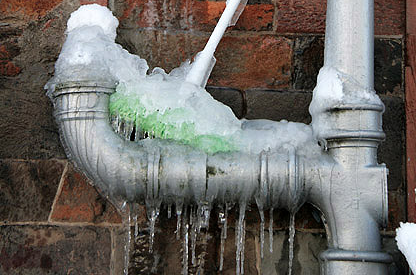How to Defend Your Pipes from Freezing: Specialist Advice
How to Defend Your Pipes from Freezing: Specialist Advice
Blog Article
We have encountered the article involving Prevent Frozen Pipes down the page on the web and believe it made good sense to relate it with you on this page.

Winter can ruin your pipes, particularly by freezing pipelines. Right here's how to stop it from taking place and what to do if it does.
Introduction
As temperature levels drop, the danger of frozen pipelines rises, possibly resulting in pricey repairs and water damage. Recognizing exactly how to prevent frozen pipes is critical for property owners in cold climates.
Recognizing Icy Pipelines
What causes pipelines to ice up?
Pipes ice up when subjected to temperature levels below 32 ° F (0 ° C) for expanded durations. As water inside the pipes ices up, it expands, taxing the pipeline wall surfaces and possibly creating them to burst.
Dangers and problems
Icy pipes can cause water system disturbances, building damages, and costly repair work. Ruptured pipes can flooding homes and create considerable architectural damages.
Indications of Frozen Pipeline
Identifying icy pipelines early can avoid them from bursting.
Exactly how to recognize frozen pipes
Seek decreased water flow from taps, uncommon odors or noises from pipes, and visible frost on subjected pipelines.
Avoidance Tips
Insulating susceptible pipes
Wrap pipes in insulation sleeves or utilize warm tape to secure them from freezing temperature levels. Concentrate on pipelines in unheated or external locations of the home.
Home heating methods
Maintain interior spaces effectively heated up, particularly areas with plumbing. Open cupboard doors to enable warm air to circulate around pipes under sinks.
Securing Exterior Pipes
Yard hose pipes and exterior taps
Disconnect and drain pipes yard tubes prior to winter season. Mount frost-proof spigots or cover exterior faucets with protected caps.
What to Do If Your Pipes Freeze
Immediate actions to take
If you believe frozen pipelines, keep faucets available to eliminate stress as the ice thaws. Use a hairdryer or towels taken in hot water to thaw pipelines gradually.
Long-Term Solutions
Architectural adjustments
Think about rerouting pipelines far from outside wall surfaces or unheated locations. Add extra insulation to attics, cellars, and crawl spaces.
Updating insulation
Purchase top notch insulation for pipes, attics, and wall surfaces. Appropriate insulation helps keep constant temperatures and lowers the danger of frozen pipelines.
Conclusion
Protecting against frozen pipelines needs aggressive steps and fast reactions. By recognizing the causes, indicators, and safety nets, house owners can shield their pipes throughout winter.
6 Proven Ways to Prevent Frozen Pipes and Protect Your Home
Disconnect and Drain Garden Hoses
Before winter arrives, start by disconnecting your garden hoses and draining any remaining water. Close the shut-off valves that supply outdoor hose bibs and leave the outdoor faucet open to allow any residual water to drain. For extra protection, consider using faucet covers throughout the colder months. It’s also important to drain water from any sprinkler supply lines following the manufacturer’s directions.
Insulate Exposed Pipes
Insulating your pipes is an effective way to prevent freezing. Pipe insulation is readily available at home improvement stores and is relatively inexpensive. Pay close attention to pipes in unheated areas such as the attic, basement, crawl spaces, or garage. Apply foam insulation generously to create a buffer against the cold. You can also wrap your pipes in heat tape or thermostat-controlled heat cables for added warmth.
Seal Air Leaks
Inspect your home for any cracks or openings that could let in cold air. Seal any holes around the piping in interior or exterior walls, as well as the sill plates where your home rests on its foundation. Additionally, make sure to keep your garage door closed unless you’re entering or exiting. Leaving it open creates a significant air leak that can lead to frozen pipes.
Allow Warm Air Circulation
During cold snaps, it’s essential to allow warm air to circulate evenly throughout your home. Leave interior doors ajar to promote better airflow. Open kitchen and bathroom cabinets to help distribute heat consistently around the rooms. If you have small children or pets, be sure to remove any household chemicals or potentially harmful cleaners from open cabinets for safety.
Let Faucets Drip
A small trickle of water can make a big difference in preventing ice formation inside your pipes. When temperatures drop significantly, start a drip of water from all faucets served by exposed pipes. This continuous flow helps prevent the water from freezing. Additionally, running a few faucets slightly can relieve pressure inside the pipes, reducing the chances of a rupture if the water inside does freeze.
https://choateshvac.com/6-proven-ways-to-prevent-frozen-pipes-and-protect-your-home/

I discovered that content on Prevent Frozen Pipes when scouting around the internet. Are you aware of another person who is excited about the topic? Why not promote it. I love your readership.
Quote & Schedule Report this page